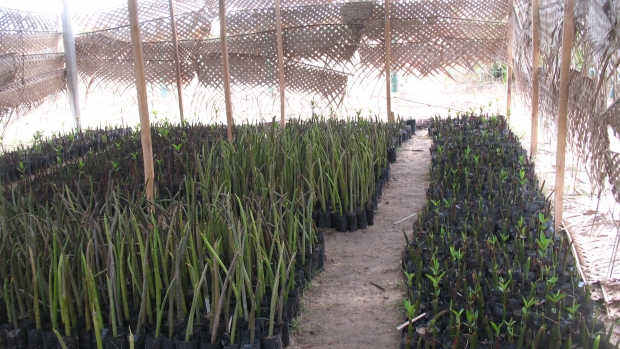Grants :: Small Grant Facilities :: Replanting mangroves in Pottuvil lagoon
Replanting mangroves in Pottuvil lagoon

Mangrove nursery Pottuvil, Sri Lanka © KEkaratne, 2009
Objectives
This project had three objectives:
- To restore the livelihoods of local people dependent on Pottuvil lagoon;
- To support participatory mangrove rehabilitation and management; and
- To raise awareness locally of the need to conserve the lagoon and mangrove ecosystems.
Background
Pottuvil is one of the most vibrant and productive coastal areas in Sri Lanka. The Kottukal area surrounding Pottuvil lagoon is a well-known tourist destination. Rich in biodiversity, it still has some healthy mangrove stands. Although the local fishing community obtains a wide range of benefits from these mangroves, they are under constant pressure from over-exploitation and clearing for other land uses. The 2004 Indian Ocean tsunami also caused severe damage to the mangroves and the wider environment in Kottukal and surrounding areas.
Manthode is a village bordering Pottuvil lagoon. Its main livelihood is fishing, but villagers have noticed a decline in their catches which they attribute to the gradual loss of the mangroves. True Vision Rural Rehabilitation Organization, an NGO based in Pottuvil, sought to rehabilitate some of the degraded mangroves and thereby improve fish catches and incomes.
Target beneficiaries
The fishing community in the Kottukal area, in particular Manthode village.
Outputs
- Increased awareness of the importance of mangroves
- Organisation of two community mangrove conservation groups
- Establishment of three community-operated nurseries
- Propagation and replanting of 10,000 mangrove seedlings
Accomplishments and challenges
The project highlighted the importance of the remaining mangroves to community livelihoods, and organised two community conservation groups. The lagoon fishermen of Manthode are now more aware of the role that mangroves play in their livelihood, motivating them to protect the remaining mangroves in their area.
Project beneficiaries increased their skills and knowledge in setting up and maintaining nurseries and planting mangroves. Three community-operated nurseries were established, raising 10,000 mangrove seedlings (9,000 Rhizophora spp. and 1,000 Avicennia spp.). These seedlings were used to replant and rehabilitate an area of mangroves.
Challenges:
A major challenge was poor weather – a severe drought which killed 3,000 seedlings in the nurseries and increased the salinity of Pottuvil lagoon was followed by heavy rains and flooding.
Contributions to cross-cutting themes
Though planting was mainly carried out by men, women assisted men in nursery maintenance.
Lessons Learned
The community must be mobilised and integrated into all activities if projects of this type are to succeed. Community groups will be key to sustaining efforts to propagate mangrove seedlings.
At the outset of this type of project, potential planting sites should be assessed and tested before any action is taken. It is also important to establish nurseries in areas where fresh water is readily available.
Project Facts
Country
Location
Kottukal, Pottuvil, Sri Lanka
Topic
Duration
1st Jan 2009 to 31st Dec 2009
MFF Grant Amount
US$4,018
Implementing Partner
True Vision Rural Rehabilitation
Organization
30 Shariff Hakiya Road,
Addalaichenai, Sri Lanka
Tel: +94 71 4456412
“The project beneficiaries gained knowledge in establishing and maintaining a plant nursery, and planting and maintaining mangroves.”
— Mr M. A. C. M. UVAIS
Project Coordinator
